Kenpo History
Click here to see Logan's Family Tree
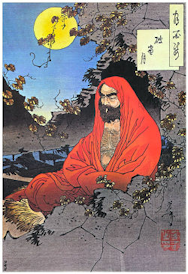
Bodhidharma
It is estimated that in 520 AD during the Southern dynasties that Bodhidharma entered China and traveled
northward to the kingdom of Wei where the fabled meeting with emperor Wu of the Liang dynasty began. This
meeting is recorded do to the intense conversation and discussion of Buddhism and dhyana which took place.
The meeting was to no avail, his words to the worldly emperor meant nothing, and thus, sullened by his attempts,
Bodhidharma left the palace of the emperor and traveled to the Hunan province where we entered the Shaolin
temple and began a martial history.
At the beginning of the seventeenth century two families, Kumamoto and Nagasaki brought knowledge of Kempo from China to Kyushu in Japan. This art was modified throughout many years into its current form which is referred to as Kosho ryu Kempo, or Old Pine Tree school and it is from here that most modern forms of Kempo are derived. In 1916 at the age of five, James Mitose was sent to Kyushu from his homeland in Hawai for schooling in his ancestors are of self-defense called Kosho ryu Kempo. For fifteen years he studied this art which was a direct descendent of the original Chuan Fa. After completing his training in Japan, Mitose returned to Hawaii and in 1936 opened the "Official Self-Defense" club in Beretania mission in Honolulu. It was here that the five major Kempo influences; Thomas Young, William Chow, Edmund Howe, Arthur Keawe and Paul Yamaguchi would study and bring Kempo to the world.
In 1934, before Mitose's return to the United States, the term Kempo-Karate was first used. In an issue of Yoen Jiho Sha newspaper an advertising for the visit of Chogun Miyagi, a famous karateka and founder of Goju ryu karate do, to the island of Hawaii. The use of the two terms is under speculation. Some suspect it was simply an advertising scheme while others believe that Chogun Miyagi's Goju ryu was actually a pure form of Kempo, and that the term karate was simply more well known.
William Chow is perhaps responsible for the largest leap of Kempo to the general public. William K.S. Chow studied Kempo under Mitose for several years and previously had studied his families art of Kung Fu. Chow united, like many Kempo masters before him the arts of Kosho ryu Kempo and his family Kung fu to form a new art which would eventually be referred to as Kara-ho Kempo. In 1949, Chow had attracted a number of students to his own teachings and opened a dojo of his own at a local YMCA. To make a distinct variation from Mitose's Kempo, Chow referred to his art as Kenpo Karate. Throughout the next few decades Chow made many innovations to the system including the use of circular techniques of his Kung Fu, as well as various kata or forms based on the primary linear and circular techniques of his art.
One of Chow's most flourishing students was a Hawaiian native named Edmund Parker. In 1954 Edmund Parker earned his black belt in kara-ho Kempo. Ed Parker further refined and defined the techniques of Kara-ho Kempo till he perfected his American Kenpo Karate system. Ed Parker is often referred to as the father of American Karate.
Different Styles of Kenpo
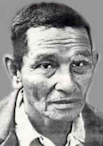
James Mitose
KOSHO RYU KEMPO - This style of Kempo was brought by visiting monks to to the Mitose family in the 15th century. Over the centuries this form of Shaolin Chuan Fa was blended and refined with forms of Jujutsu that where common to the area as well as Rinzai Zen philosophy, Kyudo, and other arts. Kosho, the name of the Mitose clan means "Old Pine Tree", and the Kempo art is referred to as "The Old Pine Tree Style." The current "grandmaster" of Kosho-ryu Kempo is Bruce Juchnik who uses the term Kosho Shoreiryu Kempo to describe Mitose's school of Kempo. Mitose's son Thomas Barrow Mitose also teaches the true form of his fathers art and is considered by some the true grandmaster of the Kosho ryu style.
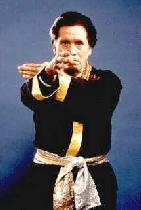
Professor William Chow
KARA-HO KENPO - Founded by William K.S. Chow, a student of James Mitose, this Kempo offshoot is a blend of the Kosho ryu Kempo and 5-animal Kung Fu of the Chow Family. Kara-ho Kenpo utilizes many circular as well as linear techniques and requires 500 such techniques to be learnt for black-belt status. Currently, Karaho Kenpo is under the evolution of Sam Kuoha who has added various new techniques as well as 12 kata based on Chow's original 12 base linear techniques. Karaho Kenpo is currently the fastest growing Kempo organization with currently over 5000 members to its teachings.
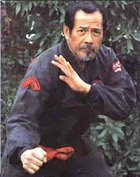
Sijo Adiano Emperado
KAJUKENBO - The Five Styles that make up the style and name of Ka-Ju-Ken-Bo are Karate, Ju-Jitsu, Kenpo, Chinese Boxing. The Five Black Belts that developed Kajukenbo, they called themselves "The Blackbelt Society" in the Paloma District of Hawaii are Peter Choo(karate), Frank Ordonez & Joe Holke,(judo-jujitsu) Adriano Emperado(kenpo), Clarence Chang(kung-fu). They based it around the Chinese Kenpo of Sijo Adriano Emperado.
Kajukenbo stresses the following up of techniques using the opponent's reactions and not stopping with just one strike. A major ethical point is "If they start the fight, you decide how it ends". Kajukenbo concentrates on being effective at all ranges of fighting, kicking, punching, trapping, and grappling. The training is physically intense and demanding.
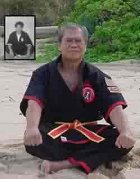
Sijo Victor "Sonny" Gascon
KARAZENPO GO SHINJUTSU - This style was formed when Sijo Victor "Sonny" Gascon left the Kajukenbo system and formed the system of Karazenpo Go Shinjutsu. Grandmaster George Pesare trained with Sijo Gascon in California before returning to Rhode Island and opening a school. Grandmaster Pesare expanded the system with the addition of Katas and Self Defense techniques. Many systems such as Villari's, Masters, United Studios of Self Defense, Masters of Karate and portions of Nick Cerios Kenpo all are linked to this system.
If you are familiar with Kenpo descriptions such as 1-5 Kata, Statue of the Crane, combinations 1-26 than you are a descendent of Karazanpo Go Shinjutsu.

Professor Nick Cerio
NICK CERIO'S KENPO - Nick Cerio's Kenpo was founded in 1974 and credits both Chow and Parker with the creation of the style. Nick Cerio received his first blackbelt from Grandmaster George Persare in Rhode Island. The Cerio Kenpo school believe in the "old method of training", and teaches most of the Shotokan forms, kung fu and Kajukenbo forms, TKD kicks, Japanese stances, as well as Jujtusu. Weapons of both Chinese and Japanese systems are taught and maintains many traditional forms. Cerio calls Chow his "teacher" and Parker his "coach".
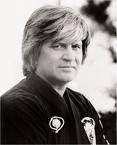
Grandmaster Ed Paker
AMERICAN KENPO - An offspring of Kara-ho Kenpo, Ed Parker's American Kenpo system is the largest and most well organized system in existence. Parker took what Professor Chow taught him and organized every technique and movement into a format that could be broken down into levels for all students. Parker felt that innovations he added to his Kenpo eventually made up 85% of the system and thus he renamed it American Kenpo Karate. The American Kenpo system can proudly be seen in the moves "The Perfect Weapon", and "Street Knight" starring 4th dan, Jeff Speakman, one of the heads of the United Kenpo Karate Association and protege of Ed Parker.

Grandmaster Fred Villari
SHAOLIN KEMPO - The Shaolin Kempo system was formed by Fred Villari, a student of American and Shorinji kempo systems. Fred Villari received his first blackbelt from Nick Cerio. Fred Villari's system tends more towards the Kung-Fu element and utilizes the techniques of the 5 animal Chuan Fa to a large extent. Added to the Kempo system was white tiger Chin na techniques as well as various Aikijutsu projections and immobilizations. Fred Villari created one of the largest martial arts organizations in the world.
What Martial Arts Compose the Curriculum of Kempo?
In general, most systems of Kempo consists of 4 primary arts which can be seen in 95% of Kempo system in both Okinawian and Japanese systems of Kempo, and consist of primarily Chinese influences.
- 18 hands of Lo Han
- 5 Animal Chuan Fa
- White Tiger Chin Na
- Jui-jutsu
Other arts that can be found in Kempo schools include:
- Kajukenbo and Karazenpo Go Shinjutsu
- Aikido or Aikijutsu
- White Crane Kung Fu
- Various weapon arts
Does Kempo Use Other Weapons Other Than Hands and Feet?
In Kempo schools, defenses against knives and clubs are seen from yellow belt and up, and are considered prime weapons in which to defend against. Kempo also teaches its students how to use weapons to increase there understanding of defense. Weapons that are taught are both Chinese and Japanese in variety and vary widely. Some schools of Kempo teach the 8' staff, while others teach Chain Whip, and sai. Weapon training often begins at the green belt level, although in some schools it is restricted to those of black belt level and higher. In most Kempo schools, the primary weapon skills taught are:
- Knife
- Stick(s)
- 6' Staff
- Sword
- Chain
Special thanks to Mark Urbin for the parts excerpted from his Kenpo FAQ.








